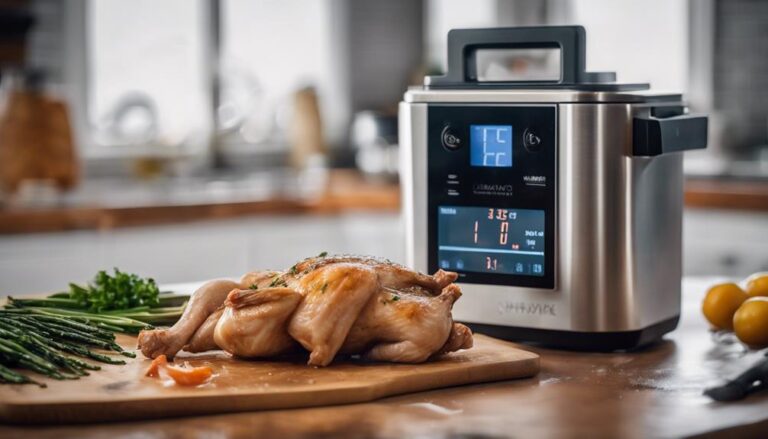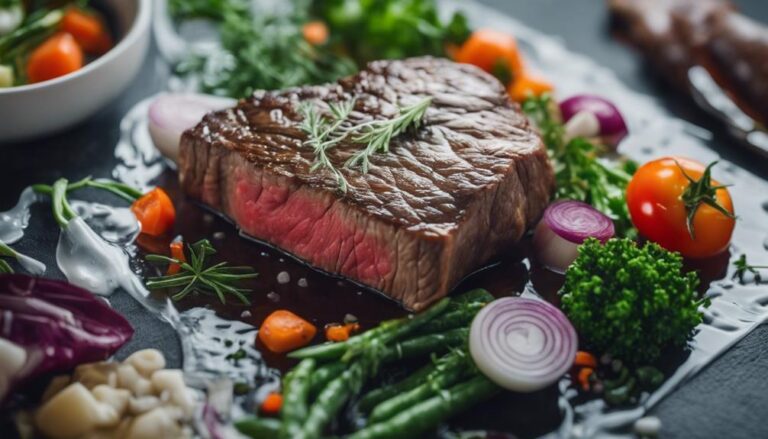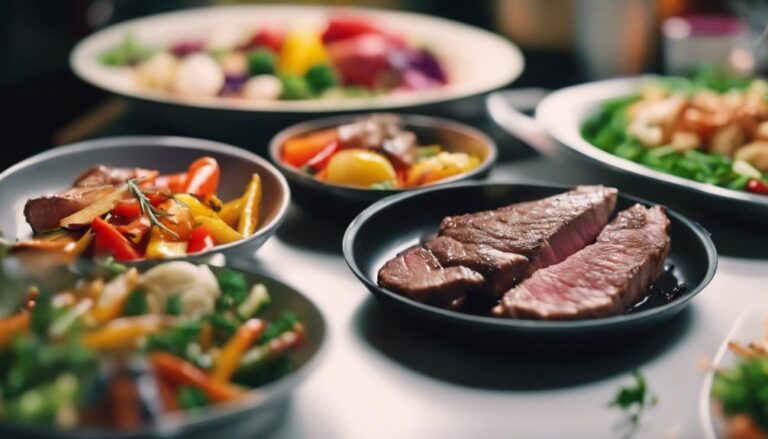Achieve Success With Home Sous Vide Cooking Techniques
Master sous vide basics with precise temperature control. Invest in quality tools for consistent results. Time and temperature are essential for perfect doneness. Try meats, seafood, and veggies for varied flavors. Sear meat for a tasty crust. Troubleshoot with proper maintenance. Advance skills with different cuts and techniques. Guarantee safety with accurate temperature monitoring. Explore resources for expert guidance. Elevate your cooking with home sous vide techniques for impressive meals that will leave you wanting more.
What You Will Learn Here
- Invest in a quality sous vide machine for precise cooking control.
- Use vacuum-sealed bags or containers with lids for sealing ingredients.
- Monitor and adjust cooking time for desired texture and taste.
- Experiment with various foods to elevate your sous vide skills.
- Master the art of searing for enhanced flavor and visual appeal.
Sous Vide Basics for Beginners
If you're new to sous vide cooking, starting with basic foods like fish or poultry can help you grasp the technique efficiently. Sous vide cooking is all about precise temperature control, ensuring your food cooks evenly from edge to edge. This method utilizes immersion circulators to maintain a constant temperature in the water bath, creating a perfect cooking environment for your ingredients.
For beginners, mastering the art of sous vide with simpler foods like fish and poultry is a great starting point. These foods are more forgiving and can help you understand how precise temperature control leads to tender textures and controlled doneness. With sous vide, you can achieve consistent and impressive results every time you cook.
Essential Tools for Home Sous Vide
Shifting from mastering fundamental foods like fish and poultry, the foundation of your sous vide journey at home lies in acquiring the necessary tools for this precise cooking method. To excel in sous vide cooking, start by investing in a quality sous vide machine, also known as an immersion circulator. This tool guarantees precise temperature control, allowing you to achieve consistent and perfectly cooked results every time.
Additionally, vacuum-sealed bags are crucial for sealing your ingredients before immersing them in the water bath. If you don't have a vacuum sealer, plastic containers with lids can serve as an alternative for cooking sous vide at home. To keep the bags in place and prevent them from floating, convenient binder clips are essential. These clips securely fasten the bags to the side of the container.
Lastly, don't forget to have tongs on hand for safely handling the food pouches during and after cooking. By equipping yourself with these necessary tools, you'll be well-prepared to commence on your sous vide culinary adventures and impress your guests with restaurant-quality meals.
Perfecting Time and Temperature Control

To achieve precise and consistent results in sous vide cooking, mastering time and temperature control is essential. Here are three vital tips to help you perfect your sous vide cooking technique:
- Understand the Sous Vide Process: Familiarize yourself with the sous vide method, where food is vacuum-sealed in a bag and cooked in a water bath at a precise temperature for a specific period. This gentle cooking process retains moisture and guarantees even cooking throughout the food.
- Monitor Cooking Time: Different foods require varying cooking times to achieve the desired level of doneness. It's important to follow recommended cooking times for each type of food to guarantee perfect results. Adjusting the cooking time can have a significant impact on the texture and taste of your dishes.
- Maintain Temperature Control: Consistently monitor and adjust the water bath temperature to match the desired doneness of the food. Precise temperature control is key to achieving consistent results and making sure that your dishes are cooked to perfection from edge to edge.
Ideal Foods for Sous Vide Cooking
After perfecting time and temperature control in sous vide cooking, you can now explore the ideal foods suited for this precise cooking technique. Sous vide is a versatile cooking method, particularly excelling with meats like beef, pork, lamb, and poultry. These proteins benefit greatly from the precise temperature control of sous vide, resulting in tender, juicy, and flavorful dishes. Fish and seafood are also excellent choices for sous vide preparation, as the gentle cooking method helps retain their delicate textures and flavors perfectly. Vegetables such as carrots, asparagus, and potatoes can also be elevated through sous vide cooking, preserving their nutrients and natural taste.
Whether you're looking to serve a succulent steak, a perfectly flaky fish fillet, or tender-crisp vegetables, sous vide offers a foolproof way to achieve consistent, restaurant-quality results. The ability of sous vide to retain moisture and flavor makes it an ideal choice for a wide range of ingredients, particularly proteins. Experimenting with different foods in your sous vide setup will allow you to discover the full potential of this precise cooking technique.
Achieving the Perfect Sear
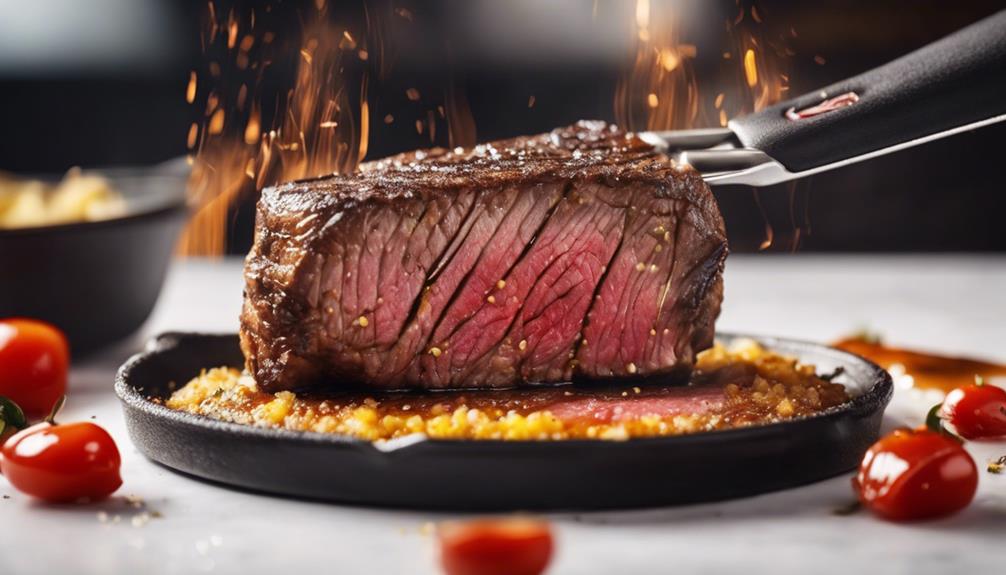
When searing your sous vide-cooked food, achieving that perfect caramelization is crucial for added flavor.
Preheat your skillet or grill to a high temperature, then pat your food dry before searing to create a better crust.
Using high smoke point oils like avocado or grapeseed oil can help you avoid burning while searing.
Searing Sous Vide Meat
You can enhance the flavor and texture of sous vide meat by searing it to achieve the perfect caramelized crust. Searing at high heat not only brings out a delightful flavor but also creates a visually appealing brown crust while maintaining the meat's tenderness.
Here are three key points to keep in mind when searing sous vide meat:
- Maintain High Heat: Utilize a hot cast-iron skillet or blow torch to guarantee a quick and effective sear.
- Develop Flavor: Searing helps reveal intricate flavors through the Maillard reaction, enhancing the overall taste profile of the meat.
- Proper Drying: Make sure the meat is sufficiently dried before searing to prevent steaming and achieve a crispy crust.
Maillard Reaction Tips
To achieve the perfect sear and maximize the full potential of your sous vide meat, mastering the Maillard reaction is essential. When searing your sous vide-cooked meat, the Maillard reaction plays an important role in developing a rich flavor profile. Here are some tips to help you achieve that mouth-watering crust:
| Maillard Reaction Tips | |
|---|---|
| Pre-dry the meat surface | Promotes browning |
| Use high heat | Develops flavorful crust |
| Rest the meat after searing | Enhances flavor and texture |
Torch Vs. Pan
For achieving the perfect sear on your sous vide-cooked meats, consider the differences between torch and pan searing techniques.
- Torch Searing: Utilizing a culinary torch offers precise heat for a caramelized crust on sous vide-prepared proteins.
- Pan Searing: Heating a skillet for pan searing creates a flavorful crust on your sous vide-cooked meats like steak and pork chops.
- Texture Differences: Torch searing provides a controlled sear, while pan searing captures additional flavors from drippings and fond.
Experiment with both methods to find the ideal searing technique that aligns with your taste preferences and desired outcomes when serving succulent sous vide dishes.
Signature Sous Vide Recipes

Pleasure your palate with a variety of mouthwatering signature sous vide recipes crafted to elevate simple ingredients into extraordinary culinary creations through precise temperatures and expert techniques. Using the sous vide method, these recipes guarantee ideal results by infusing flavors and maintaining the perfect texture in every dish. From a juicy medium-rare steak to a flavorful garlic-herb pork roast, delicate lemon-dill salmon, and savory miso-glazed carrots, each recipe highlights the versatility and precision of home sous vide cooking.
These signature sous vide recipes highlight the significance of precise temperatures and cooking times to achieve restaurant-quality results. By mastering finishing techniques such as searing, broiling, or quick pan-frying after the sous vide process, you can enhance the flavors and textures of your dishes to a new level. Experimenting with different proteins, vegetables, desserts, and eggs will broaden your culinary horizons and allow you to create impressive meals that will please your family and guests. Embrace the art of sous vide cooking at home and reveal a world of delicious possibilities.
Troubleshooting Common Sous Vide Issues
Troubleshoot common sous vide issues by maintaining water levels, checking bag seals, monitoring circulation, and addressing temperature discrepancies promptly. Here are three essential tips to help you resolve common sous vide problems effectively:
- Keep an Eye on Water Levels: Regularly check the water level in your sous vide container to prevent evaporation, ensuring consistent temperature accuracy throughout the cooking process.
- Seal Bags Properly: Make sure your bags are tightly sealed to avoid any water penetration that could compromise the quality of your dish. Proper sealing is crucial for a successful sous vide cooking experience.
- Monitor Water Circulation: Pay attention to water circulation within the sous vide bath to guarantee even heat distribution around your food. Proper circulation is essential for achieving precise and uniform cooking results every time.
Advancing Your Sous Vide Skills
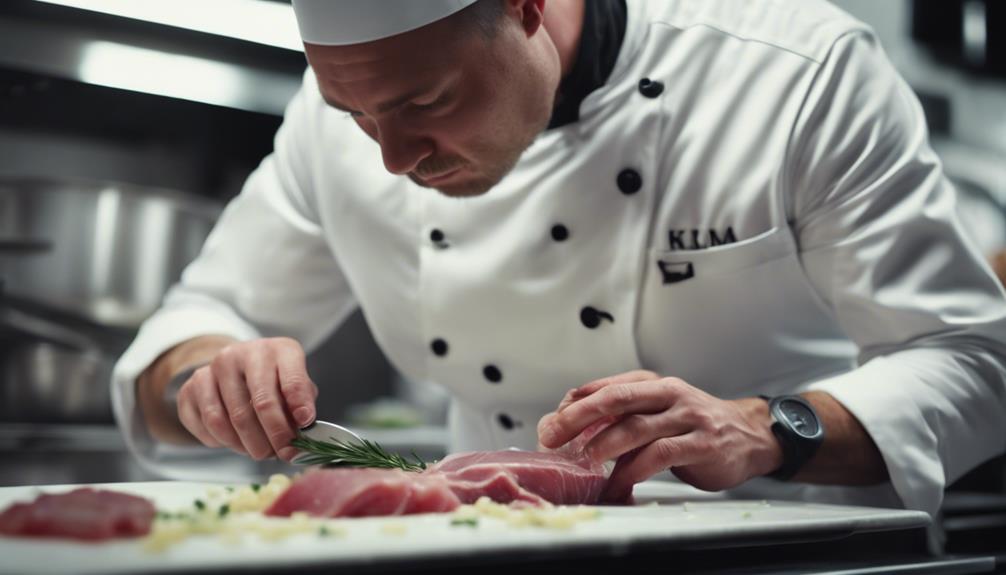
To further enhance your sous vide skills, consider exploring advanced techniques like precise temperature control for exceptional cooking outcomes. Mastering temperature control is essential in sous vide cooking as it guarantees consistent and precise results, allowing you to achieve the perfect doneness every time. Experiment with different cuts of meat to understand their best cooking times and textures, enhancing your ability to create delicious meals with sous vide.
Additionally, immerse yourself in the art of finishing techniques such as searing. Searing your sous vide-cooked food adds a beautiful caramelized crust and enhances flavors and textures, elevating your dishes to the next level. Moreover, learn how to troubleshoot common sous vide issues to guarantee consistent results and address any challenges that may arise.
Safety and Maintenance Tips
Regularly cleaning and maintaining your sous vide machine is essential for preventing bacterial growth and ensuring food safety. To keep your sous vide cooking experience smooth and safe, follow these tips:
- Proper Maintenance: Clean your sous vide machine after each use following the manufacturer's instructions. Regular maintenance will prevent the buildup of harmful bacteria and extend the lifespan of your equipment.
- Storage Procedures: Store your sous vide equipment in a clean and dry environment to avoid contamination. Proper storage will help maintain ideal performance and guarantee the safety of your food.
- Temperature Monitoring: Accurately monitor the water bath temperatures throughout the cooking process. Consistent temperature control is vital for achieving precise and delicious results while maintaining food safety standards.
Exploring Sous Vide Resources
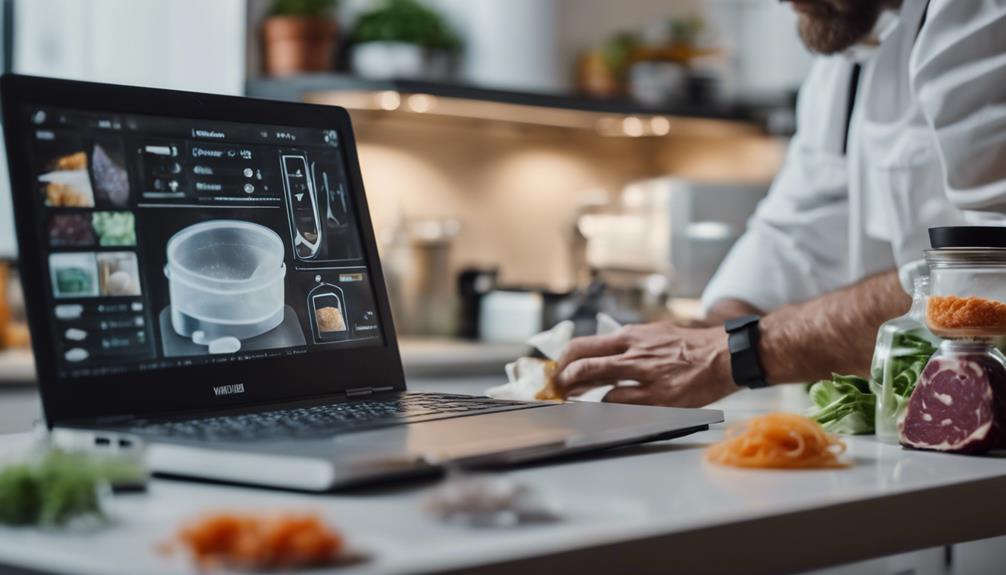
When exploring sous vide resources, you'll find valuable information on equipment options, recipe guides, and temperature control tips.
These points are essential in enhancing your sous vide cooking skills and achieving consistent, delicious results.
Equipment Options Comparison
Exploring sous vide resources reveals various equipment options for home cooks to compare, enhancing your culinary skills and meal outcomes. Here are some key points to take into account:
- Anova Sous Vide Machine: Highly recommended for quality and excellent customer service.
- Essential Supplies: Sous vide machine, plastic container, freezer bags, binder clips, tongs, spices, and herbs are essential for successful sous vide cooking.
- Vacuum Seal Bags: While used in fancy restaurants, home cooks can achieve great results without this specialized equipment.
Sous Vide Recipe Guides
As you venture into sous vide cooking, tapping into J. Kenji López-Alt's recipe guides will refine your culinary skills with precise techniques and temperature guidance.
By using the 'sous vide [meat type] j kenji' search method, you can easily find relevant posts to elevate your dishes.
Benefit from J. Kenji's experimentation and culinary expertise, which offer valuable temperature guidance for your sous vide journey.
Explore a plethora of sous vide resources on J. Kenji's main recipe page, where you can discover how this cooking method can help you achieve restaurant-quality meals at home.
Let J. Kenji's sous vide recipes be your gateway to mastering the art of precise cooking and creating impressive dishes for those you serve.
Temperature Control Tips
For precise control of temperatures in sous vide cooking, mastering the use of immersion circulators or sous vide machines is crucial. Here are three key tips to help you achieve perfect temperature control in your sous vide method:
- Calibrate Your Equipment: Make sure your immersion circulator or sous vide machine is accurately calibrated to maintain the desired temperature.
- Use High-Quality Bags: Opt for sous vide-approved bags to prevent water from seeping in and affecting the temperature consistency.
- Monitor Water Bath Levels: Regularly check and adjust the water level in the bath to guarantee even cooking and temperature stability throughout the process.
Frequently Asked Questions
What Is the Cooking Technique for Sous Vide?
To cook sous vide, seal food in bags, immerse in water, control temperature precisely for consistent cooking. Vacuum sealing locks in flavors, juices. Slow cooking at low temps guarantees perfection for meats, fish, veggies.
What Are the 6 Safety Steps for Sous Vide Cooking?
Guarantee temperature control for food safety in sous vide: monitor water immersion, utilize vacuum sealing, and distribute heat evenly. Follow FDA guidelines, cooking times, and proper storage to ensure delicious and safe results.
What Are the Principles of Sous Vide Cooking?
Maintain precise temperature control, vacuum seal ingredients for freshness, guarantee time precision, infuse flavors thoroughly, and enjoy tender results. Sous vide cooking principles emphasize attention to detail, resulting in delicious and perfectly cooked dishes every time.
What Is so Great About Sous Vide Cooking?
Benefits of sous vide cooking include precision cooking for consistent results, flavor retention, and tender texture. Effortless preparation impresses guests with high-quality dishes, showcasing your culinary skills without extensive effort.
Conclusion
Now that you've mastered the basics of home sous vide cooking, you're on your way to culinary success!
With the right tools, time and temperature control, and a little practice, you'll be creating restaurant-quality dishes in no time.
Don't be afraid to experiment with different foods and techniques to truly elevate your cooking skills.
Keep exploring and pushing yourself to new heights in the world of sous vide cooking!






